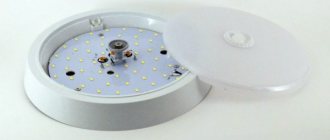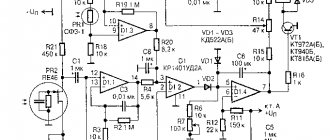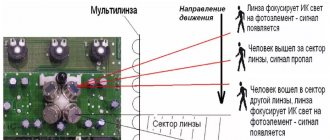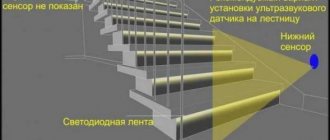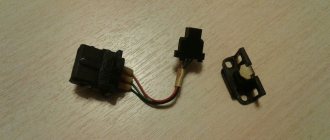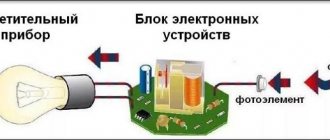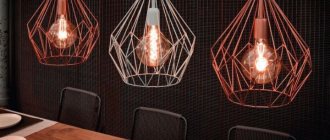Author: Alexander Starchenko
Today, the use of light bulbs with a motion sensor is an economical option for replacing conventional lamps in entrances, staircases, and other public places. Also, such lamps are used in apartments and private houses - thanks to the use of a motion sensor, you can significantly reduce energy consumption, as well as extend the life of the lamps themselves. Embedding motion sensors in lamps allows you to automatically turn on and off the light when moving objects appear, depending on the light level.
How does a motion sensor work?
The sensitive element detects the movement of any object in the lighting control zone. The lamp responds to a signal from the sensor by turning on/off.
The signal formation is caused by the reaction of the sensor’s sensitive element to changes in the parameters of the following processes:
- Change in ambient temperature. Infrared radiation from the human body, focused using lenses and mirrors, hits the sensor, which, closing the circuit, turns on the lighting.
- Changing the frequency of ultrasonic wave pulses. The sensor is equipped with an ultrasound generator. When a moving object appears in the generator's field of activity, its operating mode changes and a signal is issued to turn on the light bulb.
- Changing the parameters of the reflected signal. The principle of radar is used here. The sensor operates on high-frequency waves, which, when reflected from a moving object, change their characteristics. This causes transients inside the sensor, to which the lamp reacts by turning on.
- The information for the signal can be a symbiosis of any of the parameters presented above. Such combined systems provide better control over the surveillance area. However, servicing such devices causes certain difficulties; if they fail, a complete reconfiguration of absolutely all systems will be required.
Motion detection methods
- Infrared detection. Responsive to temperature changes. As soon as moving thermal radiation is noticed, the sensor will work. This type of detection is better used in closed areas than in open ones due to the large number of objects that can distort the picture.
- Echo and radar. Such lamps contain ultrasonic sensors that record the sound that bounces off the walls. This type of sensor is difficult to adjust to an object, so it should not be used in open areas. Ultrasonic radiation has a negative effect on animals. Devices with this detection method are designed to detect objects through obstacles.
- Capacitive method. The sensor consists of a coil and a control circuit. When the sensor detects movement, the capacitance of the electrical circuit changes, the controller recognizes this and turns on the lamp. This sensor has a fairly low sensitivity and can only detect a person at a distance of several meters. The sensor can detect not only movement, but also presence.
Another small plus is the recognition of only biological objects (that is, the lamp will not react to a leaf flying past).
There are lamps with combined sensors, but they are not very popular due to their high cost. They are highly sensitive. Often included in “smart home” packages
Lamp design features
The sensor interacts with any of the types of lamps on the market - incandescent, LED, and others. LED lamps with motion detectors are in greatest demand on the market.
In addition to the fact that they themselves provide energy savings, their compactness and ease of installation provide an advantage in competition with other lighting options.
Based on the method of using lamps, the following categories are distinguished:
- stationary, the installation of which requires the presence of a power supply network;
- portable, which operate on autonomous sources (batteries, solar and conventional batteries) and are not tied to an electrical outlet.
There are two options for connecting the sensor to the light source: remote and built-in. In a remote design, the detector and lamp are made in the form of separate elements, between which there is a wired connection. In another embodiment, the light bulb and the motion sensor are mounted in one housing.
Light bulbs with a sensitive motion sensor for the home and a similar street lamp differ in the degree of protection from external factors. Weather conditions in the form of rain, snow and other natural precipitation, temperature changes impose certain requirements on the design of a street lamp in terms of the degree of protection from dust and moisture ingress.
Installation and connection
Connection diagram
Lamps with DD are mounted according to the diagram proposed by the manufacturer. The design features a lamp and an LED element, which can be remote or built-in. The first option assumes that the sensor is placed on the ceiling or opposite the entrance, and the light source is located in a convenient location for the best illumination of the room.
In a direct connection scheme, the lamp is connected to the sensor and turns on automatically. In this system, the indicator may burn out during power surges. Simultaneously with the touch element, an ordinary key toggle switch is installed to prevent such situations. The circuit is called a bypass circuit and connects the terminals of the lamp to the electrical network and the breaker contacts.
Selection Criteria
The parameters of the motion sensor influence the characteristics of the installation location and the conditions of use. The main criteria here will be the following:
- the power must correspond to the load consumed by the lamp;
- the operating voltage is the same as in the installed circuit;
- the maximum viewing angle (usually from 30° to 360°) should ensure tracking of moving objects;
- the range of action (it ranges from 8 m to 120 m) should not be too large so as not to include the movement of foreign objects and reduce the number of unnecessary triggers;
- the recommended installation height should be at least 1.2 m in order to maximally eliminate the reaction to the movements of pets during installation, for example, in an apartment;
- The presence of a light indicator will make the operation of a light bulb with a motion sensor visually more effective.
For proper operation, it is necessary to take into account basic recommendations when choosing.
- The installation location (apartment, garage or external wall of a house) requires choosing a sensor with an appropriate degree of protection. There are no special requirements for connecting a light bulb with a motion sensor for your home.
- It is necessary to take into account obstacles during installation, for example, in the form of walls. Here, sensors that use microwaves will operate efficiently.
- If a light bulb with a motion sensor is installed in a room where there are several doors, you should choose a sensor with a 360° viewing angle and place it on the ceiling. For one input, it is enough to limit yourself to a device with a viewing angle of 180°.
- The choice of sensor range depends on the size of the controlled area. For a small apartment, a parameter of about 6–8 meters is quite enough.
Main types of LED lamps
According to their purpose, lamps are:
- For outdoor (street) lighting;
- For industrial and office premises;
- Household (for residential and utility rooms).
Based on the color of the light emitted by the lighting element, luminaires are divided into:
- Yellow (warm) glow for household lighting;
- Neutral white glow for lighting office premises and production workshops;
- White (cold) glow for street lighting;
- Multi-colored glow for decorative lighting.
Do you want to not only hear but also see those who came to you? Installing a video intercom in your apartment will increase the security of your home.
In order for video surveillance to be invisible, special hidden cameras are produced. Read more in detail at this link about spy cameras for hidden video surveillance.
Such cameras are usually connected wirelessly. Find out here how a GSM surveillance camera works and what are the advantages of this connection method.
How to connect a sensor to a lamp, options
Various connection schemes can disable/enable automatic lighting control, temporarily exclude the participation of a motion detector from control, as well as other ways to provide wider functionality with the participation of this device.
The standard circuit consists only of a motion sensor and a lamp.
Here it is important to correctly connect the sensor’s power wires to the network - phase (L) and neutral (N). The electrical circuit of the sensor and an indicator screwdriver for finding the phase will help you decide. However, the standard scheme does not have the ability to force the light on/off. If the sensor is faulty, there is a risk of being left completely without light.
The following connection modifications will help eliminate the shortcomings of the standard scheme.
- The switch is connected to the sensor in parallel. It can independently control the light on/off.
- A switch connected in series with the sensitive element has the ability to turn it off during daylight hours, that is, when it is not needed.
- A combination of the two above schemes will allow you to turn the light on/off if necessary, as well as use automation for this purpose. In this circuit, the switch must have two keys.
- Additional savings can be achieved by adding a daylight sensor to the lamp control circuit. Thus, the light device will not turn on if the level of natural light is sufficient.
We recommend reading: step-by-step instructions on how to connect a photo relay for different circuit options.
Installation of the lamp
First, let's look at installing a stationary lamp.
- The kit will include rubber seals that will need to be inserted into the designated hole on the device.
- Make sure there is a power supply nearby.
- Turn off the circuit breaker on the panel.
- The power cable is inserted into the lamp body.
- Wall or ceiling mounting.
It is necessary to remove the braid from the cable and strip the neutral and phase wires to approximately 10 mm.
Now you need to connect the wires to the terminals accordingly:
- Phase – L
- Zero – N
How to position and configure motion sensors
For the sensor to operate correctly, it is important to position it so that the capture zone is directed in the direction from which the object approaches the place where the lighting is controlled. It is not always possible to do this. In such cases, additional sensors are installed that will maximally cover all directions of approach of the object.
The sensor connection option is presented in the diagram:
If you need to expand the functionality of use, you can add a switch to the circuit.
To select operating modes after installation, you should use the settings that are available on almost all sensors.
Setting up a motion sensor to turn on the light, as can be seen from the image, includes the following basic parameters:
- Temporary settings - set the period of time during which the lighting will work from the moment the movement stops. For the controller to operate, the speed of the object plays a role. Here you should follow the recommendations - at fast speeds, reduce the time delay to a minimum, and for rooms (garage, utility room), where objects move slowly, set the delay for a longer period of time.
- By adjusting the illumination parameter, the sensor’s operation during the day and night is adjusted. If, for example, as the evening approaches, the room becomes dark, adjusting the light level will ensure that the light turns on.
- The complex indicator for the sensitivity threshold, after which the illumination is activated, includes distance adjustment and adjustment according to the size of the object. If the sensor is triggered by small extraneous movements, the sensitivity should be reduced.
Important: devices operating outdoors must be reconfigured depending on the time of year. Some of them may change under the influence of climate indicators.
Advantages
- Energy saving.
- Lamps with LED bulbs are distinguished by the highest quality and safest light. They have no light pulsation, flicker or glare.
- Versatility. Both classic incandescent lamps and powerful and economical LEDs are suitable for them.
- Different sizes of models depending on manufacturers.
Where can I buy
You can purchase smart lamps both in a specialized store and online in an online store. In the second case, the budget option for purchasing products on the AliExpress website deserves special attention. For some products there is an option for shipment from a warehouse in the Russian Federation; they can be received as quickly as possible; to do this, when ordering, select “Delivery from the Russian Federation”:
| Plutus-Quinn LED Night Light with Motion Sensor | LED ceiling lamps with motion sensor | Goodland LED Solar Light with Motion Sensor |
| Smart lamp KARWEN E27 with sound/passive IR motion sensor | LED night lights with motion sensor | Ceiling light, LED, with motion sensor |
Selection of lighting fixtures for residential premises
When choosing a lamp with DD for an apartment, you need to carefully study the location of its installation. In residential buildings, lamps of this type are installed in living rooms, offices, corridors, kitchens, utility rooms, staircases and built-in furniture. There are various modifications of lamps: external, internal and overhead - designer.
What kind of lighting do you prefer?
Built-in Chandelier
Surface-mounted lamps have a great advantage - there is no installation work during their installation. Wall lamps usually use infrared DD. The ceiling lamp design, made in a flat shape, is used for high industrial premises with a large area using an ultrasonic sensor. Motion sensors for LED lamps for household use are divided according to the location of the sensor in the design:
- Inside the case;
- a separate housing placed on the lamp;
- a separate housing located separately from the lamp;
- in a cartridge with DD.
Review of popular luminaires for residential premises with DD
| № | Indicators | CAN MEI JIA 5730 | 8-LED | 8W Bulb MS | 7 W-LED |
| 1 | Power | 5 W | 8 W | 8 W | 7 W |
| 2 | Voltage | 220 V | 220 V | 220 V | 220 V |
| 3 | Base | E 27 | G13 | E27 | E27 |
| 4 | DD | PIR | Infrared | Foton | Infrared |
| 5 | Light flow | 400 Lm | 1440.0 Lm | 550 Lm | 650 Lm |
| 6 | Luminous angle | 120 degrees | 120 degrees | 140 degrees | 110 degrees |
| 7 | Color | cool white 6500 K | white | cold white | cold white |
| 8 | MTBF | 50000 hours | 80000 hours | 30000 hour | 50,000 hour |
| 9 | LEDs | Epistar, SMD 5730, 12 pcs. | 8 pcs | 1 PC | 1 PC |
| 10 | Territory | Entrance doors, staircases, corridors, annexed areas | Living spaces | Living spaces | Living spaces |
We got together with our neighbors and bought an E27, 220V 8W Bulb MS LED lamp for the common corridor. Comfortable! No additional installation work, screwed into a regular socket and the lamp works. It shines about the same as a regular 50-watt lamp, only the lighting is brighter. We bought it because of the special sensor built into the lamp, which turns on the lamp when moving, now the light does not burn all night. It’s been working for a month now, no failures, and the neighbor also somehow connected an alarm to it so that it wouldn’t be stolen. We are happy with the purchase and don’t worry about returning home in the evening.
Hope
TOP best manufacturers in the domestic lighting market
This market segment has been firmly conquered by Chinese manufacturers, among which Feron and Mighty Light stand out. They were one of the first to present their products, which are distinguished by a powerful luminous flux.
High-quality lamps with motion sensors are offered by German manufacturers Steinel and Euroelectric. The first offers LED lamps with a motion sensor based on a sensor that perceives infrared radiation. The second specializes in outdoor options that operate in a wide temperature range. One of the best models for wall mounting is ST-69-2.
We recommend reading: how lighting of stair steps with a motion sensor can be implemented.
The Polish company Hardt supplies lamps with motion sensors protected from moisture and dust for the needs of housing and communal services; the Led-Hardt model would be an excellent choice.
Moscow and the regions of Russia are in the field of activity of numerous dealer centers and online stores, where fast delivery of any types of lamps with motion sensors will be ensured.
Degree of protection
This indicator is important if the lamp will be placed outdoors. The protection class is indicated in the documentation supplied with the device.
Denoted by IP(XY), X from 0 to 6 and Y from 0 to 9, where respectively 0 is no protection, and 6 and 9 are complete protection.
Recommendations for where to install the lamp
The location of the lamp should be chosen taking into account the characteristics of the room. The type of mounting of the lighting device also plays a role: wall, ceiling or universal. Devices intended to illuminate a large space - a room or an office - are best mounted on the ceiling, in its center, or at regular intervals if several lamps are to be installed. This way you can achieve more uniform illumination of the entire space.
It is better to install automatic sensor lights in utility rooms and at the entrance to the house directly next to the door. This way you can achieve more correct operation of the sensor, and the lamp will provide enough light to get the keys into the keyhole.
